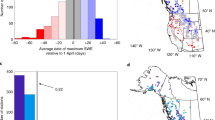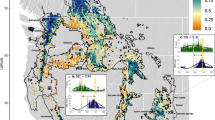Abstract
Understanding the rate of snowmelt helps inform how water stored as snow will transform into streamflow. Data from 87 snow telemetry (SNOTEL) stations across the Southern Rocky Mountains were used to estimate spatio-temporal melt factors. Decreases in snow water equivalent were correlated to temperature at these monitoring stations for eight half-month periods from early March through late June. Time explained 70% of the variance in the computed snow melt factors. A residual linear correlation model was used to explain subsequent spatial variability. Longitude, slope, and land cover type explained further variance. For evergreen trees, canopy density was relevant to find enhanced melt rates; while for all other land cover types, denoted as non-evergreen, lower melt rates were found at high elevation, high latitude and north facing slopes, denoting that in cold environments melting is less effective than in milder sites. A change in the temperature sensor about mid-way through the time series (1990 to 2013) created a discontinuity in the temperature dataset. An adjustment to the time series yield larger computed melt factors.
Similar content being viewed by others
References
Anderson E A (2006). Snow Accumulation and Ablation Model–SNOW-17. Update of technical memorandum NWS HYDRO-17 (National weather service river forecast system–snow accumulation and ablation model), Silver Springs, MD, National Oceanographic and Atmospheric Administration, 44pp
Avanzi F, De Michele C, Ghezzi A, Jommi C, Pepe M (2014). A processing-modeling routine to use SNOTEL hourly data in snowpack dynamic models. Adv Water Resour, 73: 16–29
Brubaker K, Rango A, Kustas W (1996). Incorporating radiation inputs into the snowmelt runoff model. Hydrol Processes, 10(10): 1329–1343
Colbeck S (1979). Water-flow through heterogeneous snow. Cold Reg Sci Technol, 1(1): 37–45
Cooley K, Palmer P (1997). Characteristics of snowmelt from NRCS SNOTEL (SNOwTELemetry) sites. Proceedings of the 65th Annual Western Snow Conference, Banff, Alberta, 11pp
Daly S F, Davis R E, Ochs E, Pangburn T (2000). An approach to spatially distributed snow modeling of the Sacramento and San Joaquin Basins, California. Hydrol Processes, 14(18): 3257–3271
DeWalle D, Henderson Z, Rango A (2002). Spatial and temporal variations in snowmelt degree-day factors computed from SNOTEL data in the Upper Rio Grande basin. Proceedings of the 70th Western Snow Conference, Granby, CO, 73–81
Doesken N J, Judson A (1996). The Snow Booklet. A guide to the science, climatology and measurement of snow in the United States. Department of Atmospheric Sciences, Colorado State University, Fort Collins, Colorado USA, 84 pp
Dressler K A, Leavesley G H, Bales R C, Fassnacht S R (2006). Evaluation of gridded snow water equivalent and satellite snow cover products for mountain basins in a hydrologic model. Hydrol Processes, 20(4): 673–688
Dunne T, Price A, Colbeck S (1976). Generation of runoff from subarctic snowpacks. Water Resour Res, 12(4): 677–685
Fassnacht S R, Deitemeyer D C, Venable N B H (2014). Capitalizing on the daily time step of snow telemetry data to model the snowmelt components of the hydrograph for small watersheds. Hydrol Processes, 28(16): 4654–4668
Fassnacht S R, Dressler K A, Hultstrand D M, Bales R C, Patterson G G (2012). Temporal inconsistencies in coarse-scale snow water equivalent patterns: Colorado River Basin snow telemetry-topography regressions. Pirineos, 167: 165–186
Fassnacht S R, López-Moreno J I, Toro M, Hultstrand D M (2013). Mapping snow cover and snow depth across the lake limnopolar watershed on Byers Peninsula (Livingston Island) in maritime Antarctica. Antarct Sci, 25(2): 157–166
Fassnacht S R, Records R M (2015). Large snowmelt versus rainfall events in the mountains. J Geophys Res, 120: 2375–2381
Fassnacht S R, Sexstone G A, Kashipazha A H, López-Moreno J I, Jasinski M F, Kampf S K, Von Thaden B C (2016). Deriving snowcover depletion curves for different spatial scales from remote sensing and snow telemetry data. Hydrol Processes, 30(11): 1708–1717
He M, Hogue T S, Franz K J, Margulis S A, Vrugt J A (2011). Characterizing parameter sensitivity and uncertainty for a snow model across hydroclimatic regimes. Adv Water Resour, 34(1): 114–127
Hock R (2003). Temperature index melt modelling in mountain areas. J Hydrol (Amst), 282(1–4): 104–115
Horton R E (1915). The melting of snow. Mon Weather Rev, 43(12): 599–605
Johnson J, Marks D (2004). The detection and correction of snow water equivalent pressure sensor errors. Hydrol Processes, 18(18): 3513–3525
Johnson J B, Schaefer G L (2002). The influence of thermal, hydrologic, and snow deformation mechanisms on snow water equivalent pressure sensor accuracy. Hydrol Processes, 16(18): 3529–3542
Julander R P, Curtis J, Beard A (2007). The SNOTEL Temperature Dataset. Mountain Views Newsletter, 1(2): 4–7
Kampf S K, Richer E E (2014). Estimating source regions for snowmelt runoff in a Rocky Mountain basin: tests of a data-based conceptual modeling approach. Hydrol Processes, 28(4): 2237–2250
Kumar M, Marks D, Dozier J, Reba M, Winstral A (2013). Evaluation of distributed hydrologic impacts of temperature-index and energybased snow models. Adv Water Resour, 56: 77–89
Leavesley G H (1989). Problems of snowmelt runoff modelling for a variety of physiographic and climatic conditions. Hydrological Sciences, 34(6): 617–634
Legates D R, McCabe G J Jr (1999). Evaluating the use of “goodness-offit” measures in hydrologic and hydroclimatic model validation. Water Resour Res, 35(1): 233–241
Linsley R K Jr (1943). A simple procedure for the day-to-day forecasting of runoff from snow-melt. Eos (Wash DC), 24(3): 62–67
López-Moreno J I, Alvera B, Latron J, Fassnacht S R (2010). Instalación y Uso de un Colchón de Nieve para la Monitorización del Manto de Nieve, Cuenca Experimental de Izas (Pirineo Central). Cuadernos de Investigación Geográfica, 36(1): 73–85
Lydon J, Schulz M (1986). Round. Track 4 on Album, Elektra, New York, NY
Ma C, Fassnacht S R, Kampf S K (2016). Homogenization of High Elevation Temperature Data Across Colorado. Oral presentation at the 36th Annual AGU Hydrology Days Conference, Fort Collins, Colorado, March 21–23
Martinec J, Rango A, Roberts R (2008). Snowmelt Runoff Model User’s Manual, Updated Edition 2008, WinSRM Version 1.11. New Mexico State University Agricultural Experiment Station, Special Report 100
Menne M J, Williams C N Jr, Vose R S (2015). United States Historical Climatology Network (USHCN) Daily Dataset. National Climatic Data Center, National Oceanic and Atmospheric Administration, available at: <http://cdiac.ornl.gov/epubs/ndp/ushcn/ushcn.html> (last access: 13 November 2015)
Meromy L, Molotch N P, Link T E, Fassnacht S R, Rice R (2013). Subgrid variability of snow water equivalent at operational snow stations in the western USA. Hydrol Processes, 27(17): 2383–2400
Morrisey P (2015). Personal Communication. Idaho Snow Survey Office, Natural Resources Conservation Service, U.S. Department of Agriculture
Nash J E, Sutcliffe J V (1970). River flow forecasting through conceptual models part I — A discussion of principles. J Hydrol (Amst), 10(3): 282–290
Natural Resources Conservation Service (2016a). Snow Telemetry (SNOTEL) Data Collection Network Brochure. National Water and Climate Center, U.S. Department of Agriculture, available at: http://www.wcc.nrcs.usda.gov/snotel/snotel_brochure.pdf
Natural Resources Conservation Service (2016b). NRCS: National Water and Climate Center SNOTEL data network. U.S. Department of Agriculture, available at:<ww.wcc.nrcs.usda.gov/snow/>, (last accessed: 16 December 2016)
Ohmura A (2001). Physical basis for the temperature-based melt-index method. J Appl Meteorol, 40(4): 753–761
Omani N, Srinivasan R, Smith P K, Karthikeyan R (2016). Glacier mass balance simulation using SWAT distributed snow algorithm. Hydrol Sci J
Oyler J, Dobrowski S Z, Ballantyne A P, Klene A E, Running S W (2015). Artificial amplification of warming trends across the mountains of the Western United States. Geophys Res Lett, 42(1): 153–161
Patterson G G (2016). Seasonal Snowpack Trends about Rocky Mountain National Park. Unpublished Ph.D. dissertation, Watershed Science, Colorado State University, Fort Collins, Colorado USA, 105pp + 1 appendix
Pielke R A Sr, Stohlgren T, Schell L, Parton W, Doesken N, Redmond K, Moeny J, McKee T, Kittel T G F (2002). Problems in evaluating regional and local trends in temperature: an example from eastern Colorado, USA. Int J Climatol, 22(4): 421–434
Rango A, Martinec J (1995). Revisiting the degree-day method for snowmelt computations. J Am Water Resour Assoc, 31(4): 657–669
Richer E E, Kampf S K, Fassnacht S R, Moore C (2013). Spatiotemporal index for analyzing controls on snow climatology: application in the Colorado Front Range. Phys Geogr, 34: 85–107
Sexstone G A, Fassnacht S R (2014). What drives basin scale spatial variability of snowpack properties in Northern Colorado? Cryo-sphere, 8(2): 329–344
Tobin C, Schaefli B, Nicotina L, Simoni S, Barrenetxea G, Smith R, Parlange M, Rinaldo A (2013). Improving the degree-day method for sub-daily melt simulations with physically-based diurnal variations. Adv Water Resour, 55: 149–164
U.S. Army Corps of Engineers (1956). Snow Hydrology. Summary report of the snow investigation, North Pacific Division, Portland, OR, 437pp
U.S. Geological Survey (2016). The USGS Land Cover Institute (LCI). U.S. Department of the Interior, available at:<landcover.usgs.gov>
Valéry A, Andréassian V, Perrin C (2014). As simple as possible but not simpler: what is useful in a temperature-based snow-accounting routine? Part 2- Sensitivity analysis of the Cemaneige snow accounting routine on 380 catchments. Journal of Hydrology, 517: 1176–1187
Webb R W, Fassnacht S R, Gooseff M N (in review). Defining the Diurnal Pattern of Snowmelt using a Gamma Distribution Function. Journal of the American Water Resources Association, (JAWRA-16-0153-P) (submitted July 2016)
Zeinivand H, De Smedt F (2009). Hydrological modeling of snow accumulation and melting on river basin scale. Water Resources Management, 23(11): 2271–2287
Acknowledgements
Thanks are due to the Colorado State Snow Survey office provided the GPS coordinates for the SNOTEL stations. Some of Fassnacht’s time was supported by the NASATerrestrial Hydrology Program (grant #NNX11AQ66G, Principal Investigator M. F. Jasinski, NASA Goddard Space Flight Center). Additional support was provided by the Colorado Water Conservation Board project entitled “Evaluating the Time Series Discontinuity of the NRCS Snow Telemetry (SNOTEL) Temperature Data across Colorado.” Weber was supported by the Honors program at CSU. The authors thank CSU Professor John D. Stednick for his input with this document. Thanks are also due to Karen Burke for her discussions early in this work. We also thank two anonymous reviewers who provided insightful comments that helped reshape this paper.
Author information
Authors and Affiliations
Corresponding author
Rights and permissions
About this article
Cite this article
Fassnacht, S.R., López-Moreno, J.I., Ma, C. et al. Spatio-temporal snowmelt variability across the headwaters of the Southern Rocky Mountains. Front. Earth Sci. 11, 505–514 (2017). https://doi.org/10.1007/s11707-017-0641-4
Received:
Accepted:
Published:
Issue Date:
DOI: https://doi.org/10.1007/s11707-017-0641-4




